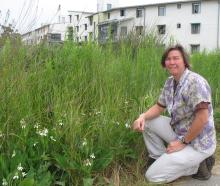
When UC Santa Barbara built the Manzanita Village student housing project in 1999, the California Coastal Commission required that it mitigate the project's impact on the neighboring wetlands by replacing lost habitat at a ratio of at least three to one.
UCSB's Cheadle Center for Biodiversity and Ecological Restoration (CCBER) worked with a Santa Barbara landscape architectural firm and civil engineers to go beyond these requirements, restoring six acres of California grassland, vernal pools, meadows, and marshes. The restoration site was awarded the American Society of Landscape Architects' 2008 General Design Award, and was featured in an eight-page section of the April issue of Landscape Architecture magazine.
While the landscape architects created a beautiful and functional design for the area, CCBER focused on the restoration of native plants and animals. Together, they created a site that is now a national model for restoration.
CCBER raised and installed more than 80,000 plants in only two years, transforming what was formerly a gravel parking lot into a rare habitat called a vernal pool that is home to many endangered plant and animal species. "We've demonstrated that we can restore functional vernal pools, because people hadn't really created them de novo like this, and it's been very successful," said Lisa Stratton, natural area director at CCBER.
The principal challenge of the restoration was creating an ecologically functional habitat in such close proximity to an urban environment. If untreated, fertilizers from the courtyard lawns and seagull guano from the residence hall roofs are washed into the ocean and nearby lagoon during rainstorms. This can cause algal blooms that are unsightly and can smother the fish.
CCBER used the excess nutrients in the water to its advantage by creating bioswales –– vegetated channels that use plants to purify water runoff before it flows into the nearby lagoon. Over 1,300 feet of bioswales treat 75 percent of Manzanita's storm water runoff.
"One of the requirements is that water that comes on the site should stay on the site," Stratton explained. "So the water soaks into the land, which, in turn, enhances the ecology of the whole area."
The design is not just effective, it's also award-winning. The Manzanita project received special recognition from the Regional Water Quality Control Board for CCBER's innovative and responsible water management.
The new habitat has drawn the attention of nearby residents, as well as bird-watchers, who have noticed a recent increase in native birds such as California Towhees, Northern Mockingbirds, and Black Phoebes. Beachside strollers can also learn about the area's plant communities by reading information signs CCBER has placed along the pathways.
"We've led the way in demonstrating that native plants can be aesthetically restored while providing education opportunities for students interested in learning about ecology and restoration," Stratton said.
CCBER has switched its focus from the now self-sustaining Manzanita restoration site to the in-progress San Clemente Villages graduate student housing restoration site, which will use bioswales to treat 100 percent of storm water runoff from the 13-acre site and the adjacent three acres of the expanded El Colegio Road.
Related Links



